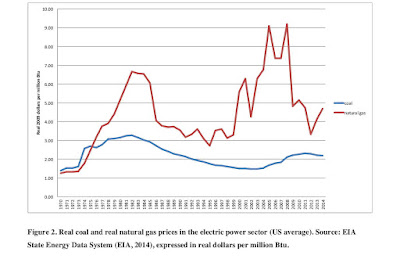I have a new working paper out, coauthored with Paul Burke and Stephan Bruns. The paper is one of those commissioned for the first year of the Energy for Economic Growth program, which is funded by the UK Department for International Development and directed by Catherine Wolfram. The paper was actually completed in January 2017, but there has been a lot of delay in getting approval for publication. The project and the paper focuses on the role of electricity in economic development in Africa and South Asia, the two regions of the world where electricity is least accessible.
Access to and consumption of electricity varies dramatically around the world. Access is lowest in South Sudan at 4.5% of households, while consumption ranges from 39 kWh per capita – this includes all uses of electricity not just household use – in Haiti to 53,000 kWh per capita in Iceland – driven by aluminum smelting. Consumption is 13,000 kWh per capita in the US. Electricity use and access are strongly correlated with economic development, as theory would suggest:
Access and consumption have increased strongly in many poorer countries in recent years – will this have beneficial effects on development? The specific questions that DFID asked us to answer were:
• How serious do electricity supply problems have to be in order to constitute a serious brake on economic growth?
• To what degree has electrification prolonged or accelerated economic growth?
• What can be learned from the development experience of countries that have invested successfully in electrification?
In principle, it should be easier to find evidence for causal effects using more disaggregated micro level data as some variables can more easily be considered exogenous, and randomized trials and other field experiments are possible. On the other hand, growth is an economy-wide, dynamic, and long-term process with effects that cannot usually be captured in micro studies. Therefore, macroeconomic analysis is also needed. Our paper is complemented by a paper covering the microeconomic aspects of these questions.
Despite large empirical literatures – such as that on testing for Granger casuality between electricity use and economic growth – and suggestive case evidence, we found few methodologically strong studies that establish causal effects for electricity use, access, infrastructure, or reliability on an economy-wide basis. The best such study that we found is a paper by Calderon et al. in the Journal of Applied Econometrics. But this paper actually tests the effects of an aggregate of different types of infrastructure on growth.
We propose that future research focuses on identifying the causal effects of electricity reliability, infrastructure, and access on economic growth; testing the replicability of the literature; and deepening our theoretical understanding of how lack of availability of electricity can be a constraint to growth.
Access to and consumption of electricity varies dramatically around the world. Access is lowest in South Sudan at 4.5% of households, while consumption ranges from 39 kWh per capita – this includes all uses of electricity not just household use – in Haiti to 53,000 kWh per capita in Iceland – driven by aluminum smelting. Consumption is 13,000 kWh per capita in the US. Electricity use and access are strongly correlated with economic development, as theory would suggest:
Access and consumption have increased strongly in many poorer countries in recent years – will this have beneficial effects on development? The specific questions that DFID asked us to answer were:
• How serious do electricity supply problems have to be in order to constitute a serious brake on economic growth?
• To what degree has electrification prolonged or accelerated economic growth?
• What can be learned from the development experience of countries that have invested successfully in electrification?
In principle, it should be easier to find evidence for causal effects using more disaggregated micro level data as some variables can more easily be considered exogenous, and randomized trials and other field experiments are possible. On the other hand, growth is an economy-wide, dynamic, and long-term process with effects that cannot usually be captured in micro studies. Therefore, macroeconomic analysis is also needed. Our paper is complemented by a paper covering the microeconomic aspects of these questions.
Despite large empirical literatures – such as that on testing for Granger casuality between electricity use and economic growth – and suggestive case evidence, we found few methodologically strong studies that establish causal effects for electricity use, access, infrastructure, or reliability on an economy-wide basis. The best such study that we found is a paper by Calderon et al. in the Journal of Applied Econometrics. But this paper actually tests the effects of an aggregate of different types of infrastructure on growth.
We propose that future research focuses on identifying the causal effects of electricity reliability, infrastructure, and access on economic growth; testing the replicability of the literature; and deepening our theoretical understanding of how lack of availability of electricity can be a constraint to growth.


































